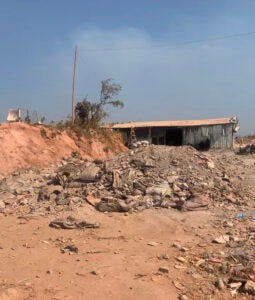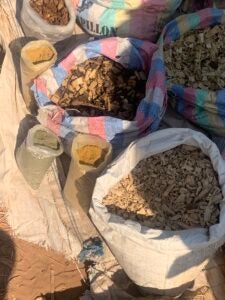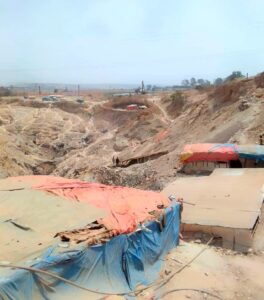By Benita Kayembe
Rose Service Learning Fellow
SM Candidate, Global Health and Population
When talking about the economic development of the Democratic Republic of the Congo, it is usual to hear people highlight how rich this country is in natural resources. The Congo is indeed rich in natural resources and lately has been at the center of discussions regarding Cobalt since up to 60% of the global reserve of this mineral is in the Congo [1]. Aims to transition to a decarbonized economy to mitigate the effects of global warming have led to a spike in demand for Cobalt. Unfortunately, many local Congolese artisanal miners are not fully benefiting from this economic boom nor the sustainability it promises.

Regarding the artisanal miners’ community, some data suggest that approximately 200,000 artisanal miners work in cobalt deposits in the Congo, another million are economically dependent on their activity [2], and the artisanal cobalt sector produces around 20% of the country’s output.” [3] Other reports show child labor in mining sites and deplorable working conditions, such the lack of proper protective equipment [4]. Being from the Democratic Republic of the Congo and led by a need to serve this marginal community, my collaborators and I decided to investigate the humanitarian dilemmas this sector raises, and we set to examine how the health of artisanal miners is affected by their working conditions. To make this possible, I was awarded a Rose Service Fellowship at the Harvard T. H. Chan School of Public Health and was able travel to Kolwezi, engage with artisanal miners, learn from their perspectives, formulate their demands, and see how together we can respond to the needs for better humanitarian and health outcomes.
Very excited about this research; for the first time, I found myself in Kolwezi, Congo, which some call the Capital of Cobalt. Before we could interact with artisanal miners, my team met with the village chief for her approval, which she gave us. Besides getting prior ethical approval from our academic institutions, respecting the land, the local hierarchy, and the people we wanted to engage with for our research were important. After this, I was open to engaging with everything I had heard about artisanal miners and mining in this part of the world.
Kolwezi is an interesting city; driving or walking through it feels like one is walking on a mining site. At the city’s entrance, multitudes of trucks are driving with tons of mines: copper, cobalt, and others, undoubtedly driving out of the country. There are giant conglomerations, mostly led by foreign nationals, with noticeable pieces of machinery needed to mine. Many told me Kolwezi is a very politicized city “where people can make millions of dollars in one day, especially foreign investors.” Yet, here I was, seeing some of the world’s most economically disadvantaged and forgotten individuals: Congolese artisanal miners.

Sons, daughters, fathers, and mothers. All genders and ages are artisanal miners who have chosen this work to find a little bit of money, eat, and survive. There is nothing healthy surrounding artisanal mining sites: no schools, healthcare centers, no toilets. Most women work near water, washing minerals with no gloves. One woman I interacted with had her 5-year-old kid with her, and that kid was also working. So many kids that I could only observe but not interact with because, in my protocol, I was not allowed to interview minors.
Besides all the international or national policies that are in place to uplift these communities, on the ground, there seems to be nothing to protect them and no one to defend their rights. Although many Congolese policies are in place to protect these vulnerable communities, it is very challenging to implement such policies in such a politicized city, hence the importance of implementation science. I am reiterating that I saw kids working in these sites and most artisanal miners, if not all, rarely wear Personal Protective Equipment. Most of them don’t earn enough, so why would one decide to buy gloves that cost 2,500 Congolese Franc ($1.25) when one is sometimes not even able to make that amount of money in one day, especially now that “the price of cobalt is down,” as many shared.
 These artisanal miners can only work in sites where they are allowed to work. And most of the time, these “allowed sites” are in spots where giant conglomerations throw their industries’ waste. And this is how it goes, per raconteurs: suppose big investors discover that artisanal miners have found a site able to produce worthwhile mines and money; they do their best to acquire the right to source minerals on that land; they have the resources to do so. Artisanal miners are then thrown away and left to find something else to mine. They go back to working where giant conglomerations throw their industries’ waste or in spots where the state has agreed they can work but where established cooperatives to protect them are not doing much. Most told me that they must drug themselves to be able to go down or up mining sites because that is very scary, but they do so because they need money. They need to survive.
These artisanal miners can only work in sites where they are allowed to work. And most of the time, these “allowed sites” are in spots where giant conglomerations throw their industries’ waste. And this is how it goes, per raconteurs: suppose big investors discover that artisanal miners have found a site able to produce worthwhile mines and money; they do their best to acquire the right to source minerals on that land; they have the resources to do so. Artisanal miners are then thrown away and left to find something else to mine. They go back to working where giant conglomerations throw their industries’ waste or in spots where the state has agreed they can work but where established cooperatives to protect them are not doing much. Most told me that they must drug themselves to be able to go down or up mining sites because that is very scary, but they do so because they need money. They need to survive.
We are in a globalized world, and many global health issues that marginalized communities face require collaboration among stakeholders and actors across the boards. We may read and publish papers about artisanal miners, other communities, and other global issues. Still, on the ground, lived realities can be harsher and more heartbroken. In this case, I saw how and what artisanal miners live. It is a worse reality. Some were so happy that finally, someone was there to talk with them and not just take from them. Being in that environment, hearing from them, their cries, and their wants, I wouldn’t have ever imagined that anyone could live like that; this could have been me; I could not stop to wonder. While some of us are happy that cobalt can produce ‘sustainable’ technology, others are dying to produce the cobalt needed to produce ‘sustainable’ technology.
Congolese cobalt artisanal miners face so many health issues. We must talk, engage, learn from, invest in, and work with them to address the problems they are facing. International, national, and local agencies in place to protect these populations must do right by them, and these artisanal miners need to be supported by all of us.
Work Cited
[1] Shengo, M. L., Kime, M.-B., Mambwe, M. P., & Nyembo, T. K. (2019). A review of the beneficiation of copper-cobalt-bearing minerals in the Democratic Republic of Congo. Journal of Sustainable Mining, 18(4), 226–246. https://doi.org/10.1016/j.jsm.2019.08.001
[2] Person, & Home, A. (2021, May 13). Column: Cobalt, Congo and a mass artisanal mining experiment. Reuters. Retrieved September 11, 2022, from https://www.reuters.com/business/energy/cobalt-congo-mass-artisanal-mining-experiment-andy-home-2021-05-13/
[2] Banza Lubaba Nkulu, C., Casas, L., Haufroid, V., De Putter, T., Saenen, N. D., Kayembe-Kitenge, T., Musa Obadia, P., Kyanika Wa Mukoma, D., Lunda Ilunga, J.-M., Nawrot, T. S., Luboya Numbi, O., Smolders, E., & Nemery, B. (2018). Sustainability of artisanal mining of cobalt in DR Congo. Nature Sustainability, 1(9), 495–504. https://doi.org/10.1038/s41893-018-0139-4
[4] BBC. (2019, June 28). DR Congo copper and cobalt miners killed in Kolwezi. BBC News. Retrieved February 28, 2022, from https://www.bbc.com/news/world-africa-48797845

You must be logged in to post a comment.